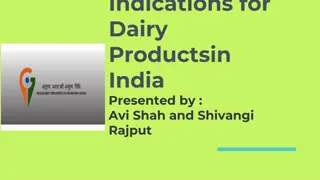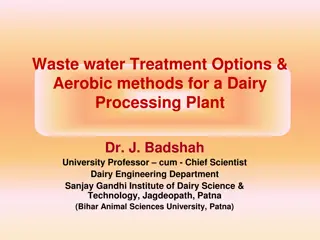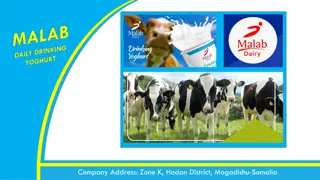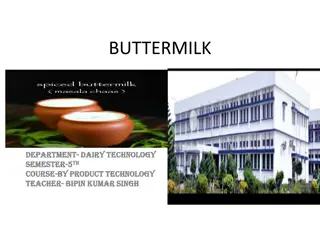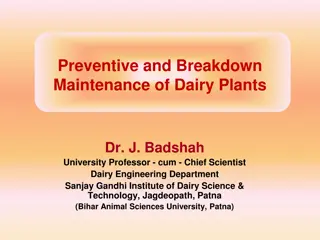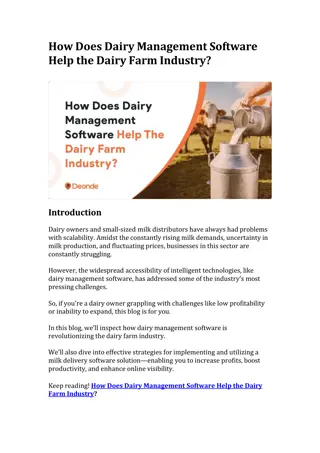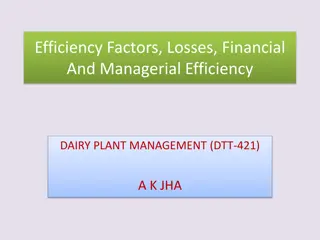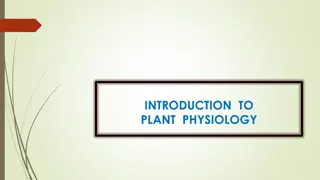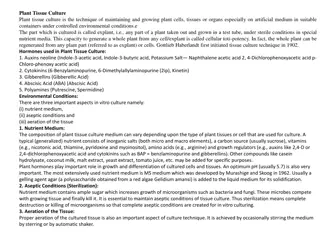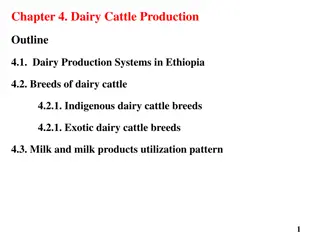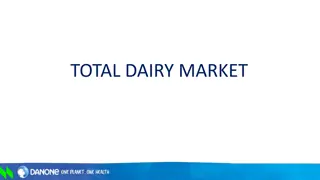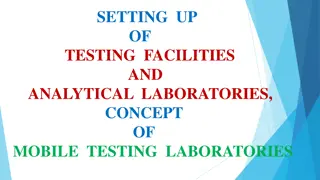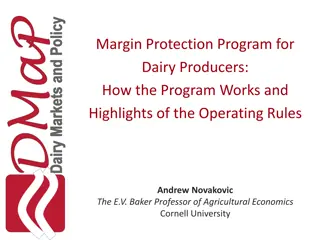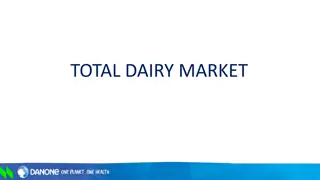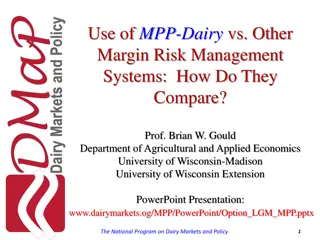Environmental Policy for Dairy Plant Siting Considerations
This content outlines the environmental elements essential for the selection and siting of dairy plants, focusing on land use, wastewater treatment, buffer distances, and protection of natural water resources. Factors like soil types, flood plains, surface water bodies, and buffer distances from residential areas are discussed to minimize environmental impacts and ensure sustainable operations.
Download Presentation

Please find below an Image/Link to download the presentation.
The content on the website is provided AS IS for your information and personal use only. It may not be sold, licensed, or shared on other websites without obtaining consent from the author.If you encounter any issues during the download, it is possible that the publisher has removed the file from their server.
You are allowed to download the files provided on this website for personal or commercial use, subject to the condition that they are used lawfully. All files are the property of their respective owners.
The content on the website is provided AS IS for your information and personal use only. It may not be sold, licensed, or shared on other websites without obtaining consent from the author.
E N D
Presentation Transcript
Antigens and the Immune Response Assist. Professor Dr. Sinan Bahjat M.B.Ch.B., M.Sc., F.I.B.M.S.
Antigens are molecules that react with antibodies, whereas immunogens are molecules that induce an immune response. In most cases, antigens are immunogens,and the terms are used interchangeably.
However, there are certain important exceptions (e.g., haptens). A hapten is a molecule that is not immunogenic by itself but can react with specific antibody.
Haptens are usually small molecules (MW is less than 10.000), but some high-molecular-weight nucleic acids are haptens as well. Many drugs (e.g., penicillins) are haptens, and the catechol in the plant oil that causes poison oak and poison ivy is a hapten.
Haptens are not immunogenic because they cannot activate helper T cells.The failure of haptens to activate is due to their inability to bind to Major Histocompatibility Complex (MHC) proteins; they cannot bind because they are not polypeptides and only polypeptides can be presented by MHC proteins.
Furthermore, haptens are univalent and therefore cannot activate B cells by themselves.
Although haptens cannot stimulate a primary or secondary response by themselves, they can do so when covalently bound to a carrier protein. In this process, the hapten interacts with an IgM receptor on the B cell and the hapten carrier protein complex is internalized.
Haptens, such as drugs (e.g., penicillin) and poison oak oil, can interact with our immune system when it bind to our normal proteins,to which we are tolerant.
The haptenprotein combination now becomes immunogenic (i.e., the hapten modifies the protein sufficiently such that when combination is presented by the MHC protein, it is recognized as foreign). the hapten peptide
Another medically important concept that is related to the hapten carrier protein model is that of conjugate vaccines such as the pneumococcal and meningococcal vaccines and the vaccine against Haemophilus influenzae.
In these conjugate vaccines, the capsular polysaccharide is conjugated to a carrier protein. The capsular polysaccharide is not a hapten because it can induce IgM via the T-independent response. However, adding a carrier protein causes helper T cells to be involved,and large amounts of IgG are produced via the T- dependent response.
The features immunogenicity of molecules that as determine follows: are Foreignness: molecules recognized as Self are not immunogenic. Molecular size: molecules with molecular weight < 10.000 is considered as non-immunogenic or weakly immunogenic. Chemical- structural complexity: A certain amount of chemical complexity is required.
Antigenic determinants (Epitopes): they are small chemical groups on the antigen molecule that can elicit and react with antibody.An antigen can have one or more determinants (epitopes). Most determinants (i.e., they are multivalent). In general, a determinant is roughly five amino acids or sugars in size. antigens have many
Dosage, administration: immunogenicity. route and These timing factors of also antigen affect
Adjuvants enhance the immune response to an immunogen. They are chemically unrelated to the immunogen and differ from a carrier protein because the adjuvant is not covalently bound to the immunogen, whereas the carrier protein is.
Adjuvants can act in a variety of ways: Cause slow release of immunogen,thereby prolonging the stimulus. Enhance uptake of immunogen by antigen-presenting cells. Induce co-stimulatory molecules. Stimulate Toll-like receptors macrophages. on the surface of
One of the important aspects of adjuvants usage in medical field is through its use in vaccine production for some types of vaccines (e.g. aluminum hydroxide and lipids) .
Cell- mediated immunity and antibodies are both highly specific for the invading organism. The process by which these host defenses originate can be summarized by three actions: Recognition of the foreign organism (i.e. antigen) by specific immune cells. Activation of these immune cells to produce a specific response (e.g.,antibodies). Response that specifically targets the organism for destruction.
When a microorganism enters the body and engulfed by the macrophage, This microorganism is broken down, and fragments of it called antigens or epitopes appear on the surface of the macrophage in association with class II major histocompatibility complex (MHC) proteins.
The antigenclass II MHC protein complex interacts with an antigen-specific receptor on the surface of a helperT lymphocyte.
Activation and clonal proliferation of this antigen- specific helper T cell occur as a result of the production of interleukins, the most important of which are interleukin-2 (T cell growth interferon (activates macrophages). factor) and gamma
In case of viral infection, cellular mediated immunity (i.e. cytotoxic T cells) are activated against virus-infected cells after appearance of viral envelope glycoproteins on the surface of the infected cell in association with class I MHC proteins.
A cytotoxic T cell binds via its antigen-specific receptor to the viral antigen class I MHC protein complex and is stimulated to grow into a clone of cells (by interleukin- 2 produced by helperT cells).
These cytotoxic T cells specifically kill the virus infected cells by recognizing viral antigen class I MHC protein complexes on the cell surface and releasing perforins that destroy the membrane of the infected cell.
The antibody-mediated immunity (antibody synthesis) typically involves the cooperation of three cells: antigen-presenting cells (e.g., dendritic cells and macrophages),helperT cells,and B cells.
After processing by an antigen-presenting cell, fragments of antigen appear on the surface of that cell in association with class II MHC proteins.
The antigenclass II MHC protein complex binds to receptors on the surface of a helper T cell specific for that antigen. This activates the helper T cells to produce interleukins such as interleukin-2 (IL-2), IL-4, and IL-5. These interleukins activate the B cell to produce antibodies specific for that antigen.
The activated B cell proliferates differentiates to form many plasma cells that secrete large amounts of immuno- globulins (antibodies). and then
Although antibody formation usually involves helper T cells, certain antigens (e.g., bacterial polysaccharides) can activate B cells directly, without the help of T cells, and are called T cell independent antigens. In this T cell independent response, only IgM is produced by B cells.
The B cells functions can perform during two the important induction process: They recognize antigens with their surface IgM that acts as an antigen receptor. They present epitopes to helper T cells in association with class II MHC proteins.
The IgM antigen receptor on the B cell can recognize not only foreign proteins but also carbohydrates, lipids, DNA, RNA, and other types of molecules. The class II MHC proteins of the B cell, however, can only present peptide fragments to the helperT cells.




